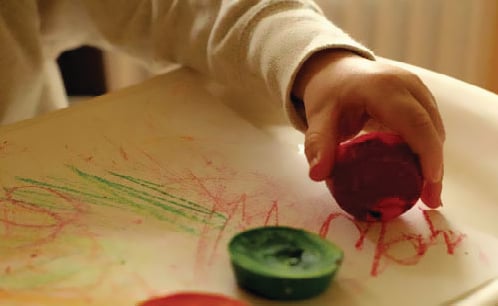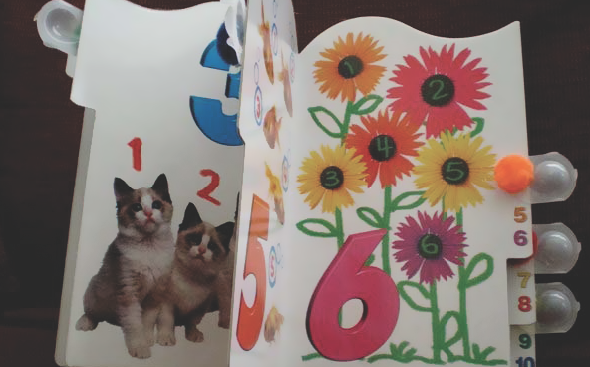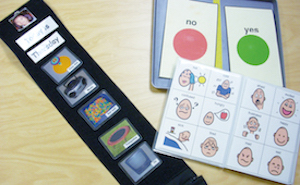
Technology and Communication
Techniques and Devices Can Help a Child Learn to Communicate
Most people use speech and language to indicate their needs and choices or to socialize. Some children, however, have difficulty learning to talk, and others cannot use their voices at all. Fortunately, augmentative communication methods, technology, and therapy can help them communicate.
Communication skills generally develop in predictable stages early in a child’s life. If parents detect that their child has difficulty speaking, they should seek advice from a physician, early childhood specialist, or speech therapist as soon as possible. Professionals can test for hearing loss as well as other reasons for speech impairment. They can also suggest ways to help that may range from simple activities parents can do with the child at home to lifetime use of sign language or a communication device.
Parents are sometimes concerned that using sign language or a device will deter their child from trying to speak. The opposite may be true. Experiencing the power of communication often encourages a child to expand efforts—and skills.
A child who needs speech aids may begin with a strategy such as using basic signs or pointing to groups of pictures. Later, as skills develop, more sophisticated tools may be appropriate. Using any equipment or method to its full potential requires training, time, patience, and consistency from the child and people in their lives, such as family members and preschool or day care staff. A child can sense, and is encouraged, when his or her efforts to communicate are acknowledged and appreciated.
For a child to use augmentative communication most effectively, people in the child’s environment must also learn and use the method, whether it be sign language, pointing to symbols in a display, or creating speech from a Voice Output Communication Aid (VOCA).
The child’s peers can also help. Children in one preschool, for example, insisted their teacher program a classmate’s VOCA with the phrase “No way!” so that he could use their language.
Some daycare providers or preschool staff may resist using augmentative communication, because they believe it takes too much time or is too difficult to learn. When they understand and see the benefits of the technique or technology, however, they often are enthusiastic about using it. Therefore, it is usually helpful for parents and communication specialists to include daycare providers and preschool teachers in deciding on a communication system and activities for using it.
School district technology centers or other organizations, such as PACER’s Computer Resource Center, may loan communication devices for families to try as they investigate the one most appropriate for their child. If the child’s communication improves with the borrowed equipment, parents can document it. The information may help the child’s Individualized Family Service Plan (IFSP) or Individualized Education Program (IEP) team provide a device or acquire funding for a long-term communication solution.
Once a communication strategy or device is selected, the IFSP or IEP team should identify the member who can expand the system to meet the child’s changing needs. For example, a technology specialist may use computer software to create a group of communication symbols or an occupational therapist may develop a book of symbols and adapt it so the child can turn the pages. A speech-language therapist may provide copies of signs used in sign language and distribute them for others to teach the child. If an augmentative device is used, someone should be assigned to care for it, as well as to program it for the child to use (such assistance is mentioned in the Individuals with Disabilities Education Act).
Forming a Communication Plan
The following steps may help to formulate a communication plan for a child who is having difficulty speaking:
- Recognize that the child is communicating in some way and will communicate. Value all appropriate attempts the child uses to express him- or herself. Be patient!
- Arrange a meeting with professionals to assess the child’s strengths and needs.
- Make a plan to help the child communicate. Consider how the child communicates now, how he or she could communicate more effectively, and what strategies or devices could be of help.
- Prepare the child’s environment to help him or her communicate. Inform and involve family members, school personnel and classmates, and people in the community, such as those at the library, favorite restaurant, or doctor’s office.
- Implement communication strategies at home and in other environments. Experiment with simple devices and methods and move to more complex ones as needed.
- Evaluate and document what works or doesn’t work. Be open to what might work better. Celebrate small victories!
Do It Yourself: Creative AT Tools for Young Children

Assistive technology (AT) doesn’t need to be expensive or complex to make a positive difference in the life of a child with a disability. Sometimes the most effective devices can be built at home by do-it-yourself families. Here are a few examples to explore.
Crayon Nibbles
Many children have an easier time grasping larger objects. Crayons in particular can be difficult for little hands to hold. To solve this problem, typical crayons can easily be adapted to make larger crayons. All you need are crayons and a muffin tin. Simply break traditional crayons into small pieces and arrange two or three crayons of the same color in each muffin mold. Bake the crayons for 6 to 8 minutes in an oven preheated to 265 degrees. Let the crayons cool for a few minutes. Then place them in the freezer for 30 minutes to make the crayons easier to remove from the pan.
All By Myself

Tiny hands sometimes have difficulty turning the pages of a book. To make this task easier, board books (books with pages made of sturdy cardboard) can be adapted with commonly found objects to allow children to read independently. For example, try attaching popsicle sticks to each page of a board book with glue to make the pages easier to turn.
My Favorite Books
Creating a personal book can help hold the attention of a child who has trouble staying focused on a book. To create a personalized book, slip printed images of family members, favorite places, or preferred toys into page protectors. Put the page protectors with pictures into a three-ring binder. Page fluffers — large tabs used to separate pages like those described above — can be added to make turning the pages easier. Enjoy the book with your child!
To learn more about these and other innovative tools, check out the new “EZ AT 2” iBook now available for free through iTunes. Printed copies of this guide for parents and professionals are also available. It contains creative ideas to help children ages birth to 3 with disabilities participate more fully in daily activities with the use of assistive technology (AT).
Books are $5 each or free to Minnesota families. A pdf copy may also be downloaded at PACER.org/stc/pubs/EZ-AT-book-2011-final.pdf .
To order, call PACER at 952.838.9000 and ask for item STC-24 or visit PACER.org/publications/stc.asp
Devices and Software Can Help Young Children Communicate

It’s no secret that children have feelings, opinions, and desires they want to express. If your child has autism, developmental delays, or any other disability that makes communication difficult, you already know how frustrating that can be for you and your child.
What you may not know is that an array of communication devices and software can help. Known as augmentative and alternative communication (AAC), these tools can help even very young children express their wants, develop stronger relationships with peers, and find inclusion in the classroom and elsewhere.
Here are two popular types of AAC you may want to consider for your child.
Picture Communication Symbols
Often the first form of AAC used by young children, picture communication symbols (PCS) consist of simple images showing objects, actions, and feelings. By pointing to a given symbol—a picture of a favorite toy, for example—your child can make choices and communicate his or her wants and needs. PCS software programs such as Boardmaker by Mayer-Johnson or Picture It by Slater Software allow you to create customized communication materials for your child. They usually contain a searchable graphics database to help you find specific symbols, such as images associated with a birthday party or your child’s morning routines. You also can use digital photos and images to create simple communication symbols and schedules.
Mid-tech Devices
If your child needs more support when communicating, a device that incorporates PCS and voice output may be a good option. This type of device features a recorded voice that “speaks” when the corresponding button or picture is activated. You may want to start with a simple one-message device such as the BigMack by AbleNet or Partner Plus Communicator by AMDI.
Once your child becomes familiar with how the device works, you may want a more advanced version that can expand his or her choices. A device with four message buttons and five levels, for example, would hold 20 pre-recorded messages. This feature provides a much broader vocabulary without additional programming and without overwhelming your child with more-complicated technology. The Go Talk 4+ by Attainment and SuperTalker by AbleNet, for example, have multiple buttons and levels.
As you explore which device might be best, look for one that motivates your child, is appropriate for his or her abilities, and offers more advanced capabilities your child could use as his or her skills develop. Depending on the situation, funding for such devices may come from you, your insurance, or your child’s school. Mid-tech devices can range from $10 to $2,500, so it’s worthwhile to try out a few before making a purchase. Many assistive technology companies and centers offer “try before you buy” loan programs. PACER’s Simon Technology Center has helpful information about funding sources, as well as a number of AAC devices you can look at and borrow.
All people need to communicate. For young children whose disabilities interfere with their ability to share their ideas, feelings, needs, and wants, AAC can offer a solution.
To learn more about AAC software and devices, contact the Simon Technology Center at 952.838.9000 or [email protected]. You may also want to check out the AAC publications at PACER.org/publications/stc.asp
Assistive Technology (AT) Booklet for Infants and Toddlers
“Discover How Assistive Technology Can Help Your Infant or Toddler Learn and Grow” explains how parents and professionals can utilize AT in the home and through early intervention services. This helpful booklet was produced through a partnership between PACER Center and Tots-n-Tech, a federally funded project that is conducting a series of national policy studies regarding AT with infants and toddlers.
To receive this free booklet, contact PACER Center at 952.838.9000 or [email protected].
